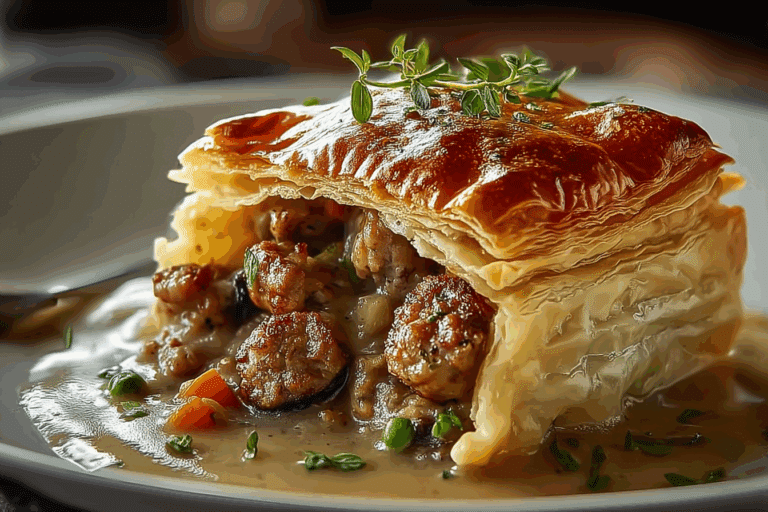Sponge Cake with Biscoff and Cream Recipe
If you’ve been on the hunt for a dessert that feels both indulgent and sophisticated yet is surprisingly easy to pull together, then this Sponge Cake with Biscoff and Cream Recipe is definitely for you. I first tried it when craving something unique—something that mixes the lightness of a sponge cake with the rich, spiced sweetness of Biscoff spread, all balanced by luscious cream. It’s a dreamy combo that works perfectly for celebrations or just a cozy weekend treat.
What I love most about this Sponge Cake with Biscoff and Cream Recipe is how versatile it is. The sponge is airy but sturdy enough to hold up to that heavenly Biscoff spread and the creamy filling. Plus, it’s a recipe you can make ahead and impress your guests without spending hours in the kitchen. Trust me, once you try it, Biscoff won’t just be for snacks anymore!
Ingredients You’ll Need
To make this cake sing, you want high-quality ingredients that complement each other beautifully. The delicate sponge relies on a fine balance of flour and cornstarch for softness, while the Biscoff spread adds that signature caramelized crunch and spice punch. Let me walk you through what you’ll want to have on hand.
- Flour: Use plain or all-purpose flour—fresh and sifted for the lightest sponge possible.
- Cornstarch: This helps keep the sponge tender, giving it that perfect, melt-in-your-mouth texture.
- Baking Powder: Just a touch to give your sponge that gentle rise without drying it out.
- Eggs: Fresh eggs are key here—they provide structure and richness to the sponge.
- Granulated Sugar: Sweetens the cake and helps create that delicate crumb.
- Vanilla Sugar: Adds a subtle vanilla aroma that pairs so nicely with Biscoff’s cinnamon notes.
- Salt: Balances out the sweetness and enhances all the flavors.
- Biscoff Spread (for filling and garnish): Look for the classic Lotus Biscoff spread to get that authentic caramelized flavor.
- Mascarpone: Rich and creamy, this is the base of the filling—so smooth and dreamy!
- Powdered Sugar: For sweetness in the cream; dissolves smoothly without any grit.
- Whipped Cream Stabilizer: Helps your whipped cream hold its shape longer, especially useful if you want to prep ahead.
- Heavy Cream: Use good-quality heavy cream for that perfect whip and richness.
- Strawberries (for garnish): Fresh, ripe berries add a pop of color and a slight tartness to balance the sweetness.
Variations
I like to mix things up depending on the season or who I’m baking for. This recipe is pretty flexible, so don’t hesitate to make it your own—whether it’s adjusting for dietary needs or just exploring new flavors.
- Gluten-Free Version: I’ve swapped regular flour for a gluten-free blend with great success; just add a little xanthan gum if your blend doesn’t contain it.
- Vegan Adaptation: Using aquafaba to replace egg whites can work, though the sponge will be less airy. A dairy-free cream substitute pairs nicely with Biscoff’s spice.
- Berry Boost: In springtime, I toss in fresh raspberries or blueberries between the layers with the cream for an extra burst of freshness.
- Chocolate Twist: Swirling in a thin layer of melted dark chocolate under the Biscoff spread is a fun way I like to surprise guests.
How to Make Sponge Cake with Biscoff and Cream Recipe
Step 1: Whip Up the Sponge Batter
Start by preheating your oven to 350°F (175°C). In a bowl, sift together your flour, cornstarch, baking powder, and salt. Meanwhile, crack the eggs into a large mixing bowl and whisk them until frothy. Then gradually add the granulated sugar and vanilla sugar while whisking at high speed—aim for a pale, fluffy, and ribbon-like batter. This aeration step is crucial as it gives your sponge that lovely lift, so don’t rush it!
Step 2: Gently Fold in Dry Ingredients
Take your sifted dry mix and gently fold it into your egg mixture in batches using a spatula. The key here is to keep as much air as possible in the batter. One tip I learned is to fold slowly but thoroughly—avoid overmixing or you’ll knock out the air and lose that tender crumb.
Step 3: Bake the Sponge
Pour the batter into a lined or greased cake pan (I love using a springform pan for easy removal) and bake for about 18-22 minutes. You’ll know it’s done when the top is golden and a toothpick inserted in the center comes out clean. Let it cool completely before moving on—that’s an easy step to forget but important for the filling to stay perfect.
Step 4: Prepare the Cream Filling
While the sponge is cooling, whip together your mascarpone with vanilla sugar and powdered sugar until smooth. In a separate bowl, whip the heavy cream with the whipped cream stabilizer until soft peaks form, then gently fold it into the mascarpone mixture. The cream should be light but hold its shape well—that’s what makes the filling irresistibly fluffy yet sturdy.
Step 5: Assemble with Biscoff Spread
Slice the sponge horizontally if you want layers, then spread a generous layer of Biscoff spread on the bottom layer. Top it with a thick layer of the mascarpone cream, then gently place the second sponge layer on top. I like to warm the Biscoff spread slightly before spreading—it glides on so much easier and doesn’t tear the sponge!
Step 6: Garnish and Chill
Finish by spreading a thin layer of Biscoff over the top and decorating with fresh strawberries. Refrigerate for at least an hour before serving to let all those flavors marry perfectly.
How to Serve Sponge Cake with Biscoff and Cream Recipe

Garnishes
For garnish, I’m a big fan of fresh strawberries because their tartness cuts through the richness beautifully. Sometimes I sprinkle a few crushed Biscoff cookies on top for an added crunch and to echo the signature spice notes. A light dusting of powdered sugar over the strawberries also adds a pretty, festive touch.
Side Dishes
This cake is rich, so I usually serve it with a simple cup of black coffee or an herbal tea to balance it out. For a fancier affair, a dollop of homemade vanilla ice cream or a scoop of lemon sorbet on the side offers a refreshing contrast that guests love.
Creative Ways to Present
One fun way I’ve served this Sponge Cake with Biscoff and Cream Recipe is in individual glass jars layered with cake, cream, and Biscoff—so easy to serve and it looks adorable! For holiday parties, I’ve also piped swirls of cream and drizzled warm Biscoff spread on mini sponge cupcakes inspired by this recipe.
Make Ahead and Storage
Storing Leftovers
I usually keep any leftover Sponge Cake with Biscoff and Cream tucked in an airtight container in the fridge. It stays fresh and moist for about 2-3 days—perfect for enjoying with a cup of afternoon tea. Just try to bring it to room temperature before serving; the flavors really blossom that way.
Freezing
If you want to freeze it, I recommend freezing the sponge separately before assembly. It freezes beautifully and thaws quickly at room temperature. Once defrosted, spread your Biscoff and cream filling fresh—this way you avoid sogginess.
Reheating
Since it’s a cream-based cake, reheating isn’t really necessary or recommended. Instead, just bring leftovers to room temperature or enjoy straight from the fridge with a warm drink. The cake’s tender crumb and creamy filling really shine when not warmed.
FAQs
-
Can I substitute mascarpone in the Sponge Cake with Biscoff and Cream Recipe?
Absolutely! If you can’t find mascarpone, cream cheese blended with a bit of heavy cream works well as a substitute, although the flavor is slightly tangier. Just be sure to beat it smooth with the sugar before folding in the whipped cream.
-
How long does the Sponge Cake with Biscoff and Cream stay fresh?
Stored properly in the fridge, it stays fresh for up to 3 days. Because it contains fresh cream, I wouldn’t recommend keeping it longer to ensure both taste and safety.
-
Can I make the Sponge Cake with Biscoff and Cream Recipe gluten-free?
Yes! Simply swap regular flour with your favorite gluten-free flour blend. Adding a small amount of xanthan gum (about 1/4 teaspoon) can help maintain the sponge’s structure and texture.
-
Is the whipped cream stabilizer necessary?
While not absolutely necessary, using whipped cream stabilizer helps your cream hold its fluffy shape longer, especially if the cake will sit out for a bit or needs to be transported. If you don’t have it, just whip the cream to stiff peaks and use the cake within a few hours.
Final Thoughts
This Sponge Cake with Biscoff and Cream Recipe is one of those treats that feels both comforting and a little fancy—perfect for when you want to impress without stress. I always get compliments when I bring it to gatherings, and it’s become my go-to when I want a dessert that’s light but satisfyingly rich. I hope you enjoy making and sharing it as much as I do—grab your Biscoff spread and give it a try, you won’t look back!
Print
Sponge Cake with Biscoff and Cream Recipe
- Prep Time: 30 minutes
- Cook Time: 25 minutes
- Total Time: 2 hours 55 minutes (including chilling time)
- Yield: 8 servings 1x
- Category: Dessert
- Method: Baking
- Cuisine: European
- Diet: Vegetarian
Description
This delightful Sponge Cake with Biscoff and Cream combines a light, fluffy sponge layered with rich Biscoff spread and a smooth mascarpone cream. Garnished with additional Biscoff spread and fresh strawberries, this dessert offers a perfect balance of sweetness and texture, ideal for celebrations or an indulgent treat.
Ingredients
Biscuit (Sponge Cake)
- 75 g flour
- 35 g cornstarch
- 3 g baking powder
- 5 eggs
- 100 g granulated sugar
- 8 g vanilla sugar
- 0.2 g salt
Filling
- 80 g Biscoff spread
Cream
- 250 g mascarpone
- 8 g vanilla sugar
- 50 g powdered sugar
- 8 g whipped cream stabilizer
- 250 ml heavy cream
Garnish
- 75 g Biscoff spread
- Fresh strawberries
Instructions
- Prepare the Sponge Cake: Preheat your oven to 180°C (350°F). In a large mixing bowl, whisk the eggs with granulated sugar and vanilla sugar until the mixture is pale, fluffy, and has doubled in volume. This aeration is key to a light sponge.
- Sift Dry Ingredients: Sift together the flour, cornstarch, baking powder, and salt to ensure even distribution of leavening agents without clumps.
- Combine Mixtures: Gently fold the dry ingredients into the egg mixture in batches, using a spatula to maintain as much air as possible for a fluffy texture.
- Bake the Sponge: Pour the batter into a greased and lined baking pan. Bake in the preheated oven for 20-25 minutes or until a toothpick inserted in the center comes out clean. Allow the cake to cool completely on a wire rack before assembling.
- Prepare the Cream Filling: In a chilled mixing bowl, combine mascarpone, vanilla sugar, powdered sugar, and whipped cream stabilizer. Whip the heavy cream to stiff peaks, then gently fold into the mascarpone mixture until smooth and creamy.
- Assemble the Cake: Once the sponge cake is cooled, slice it horizontally into two equal layers. Spread the 80 g of Biscoff spread evenly over the bottom layer, then cover with a generous layer of mascarpone cream. Place the second sponge layer on top and cover the entire cake with the remaining cream.
- Garnish: Warm the remaining 75 g of Biscoff spread slightly to make it spreadable, then drizzle or swirl it over the top of the cake. Decorate with fresh strawberries evenly arranged for a fresh fruity accent.
- Chill and Serve: Refrigerate the assembled cake for at least 2 hours to allow the cream to set and flavors to meld. Serve chilled for best texture and taste.
Notes
- Use room temperature eggs for optimal volume in the sponge.
- Be gentle when folding to maintain air in the batter for a light result.
- Chilling the cream mixture before whipping helps to achieve better structure.
- Fresh strawberries add a nice tart contrast to the sweet, spiced Biscoff flavor.
- The cake keeps well refrigerated for up to 2 days but is best enjoyed fresh.
Keywords: Sponge cake, Biscoff, mascarpone cream, dessert, strawberries, baked cake, layered cake







